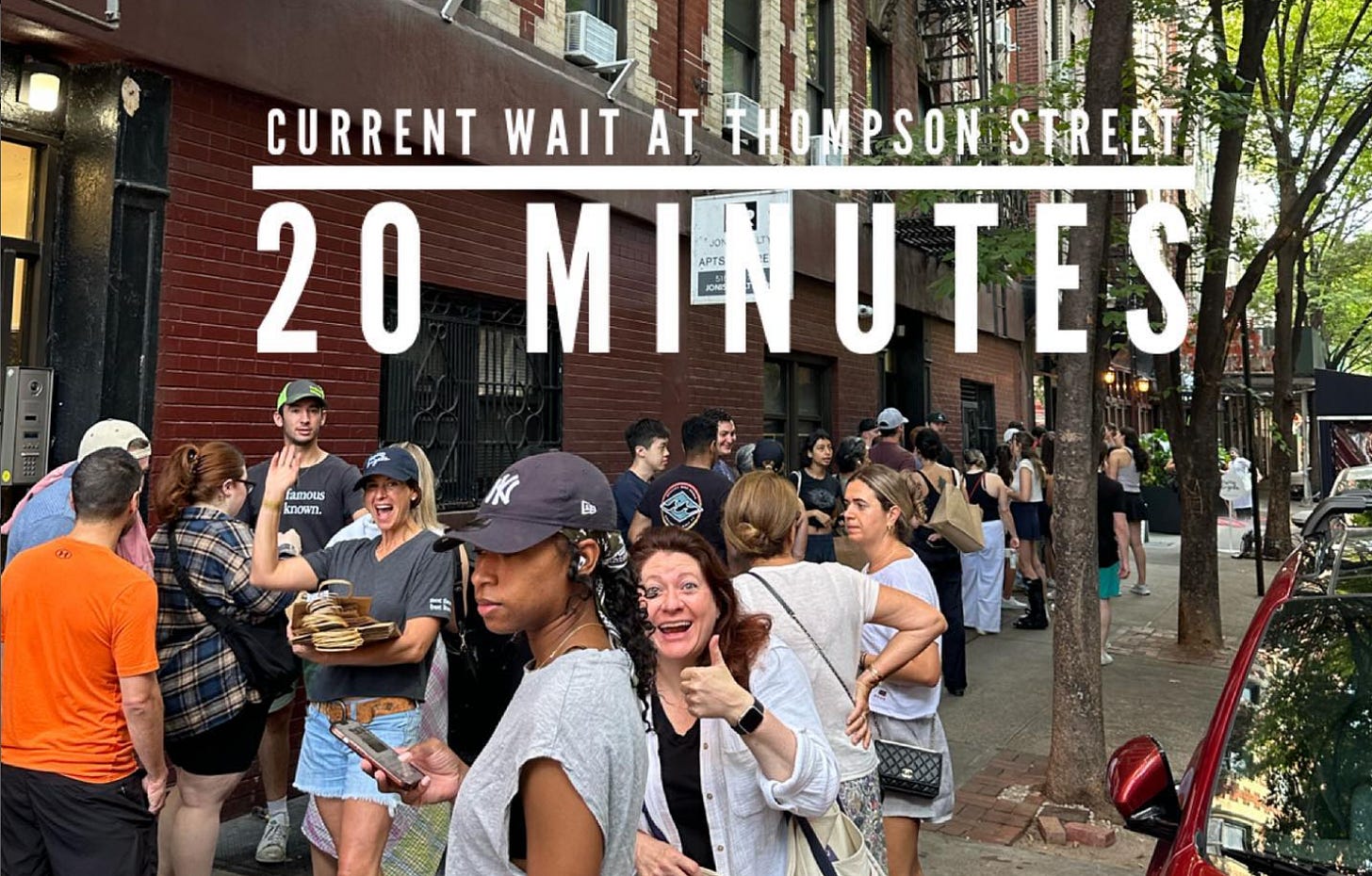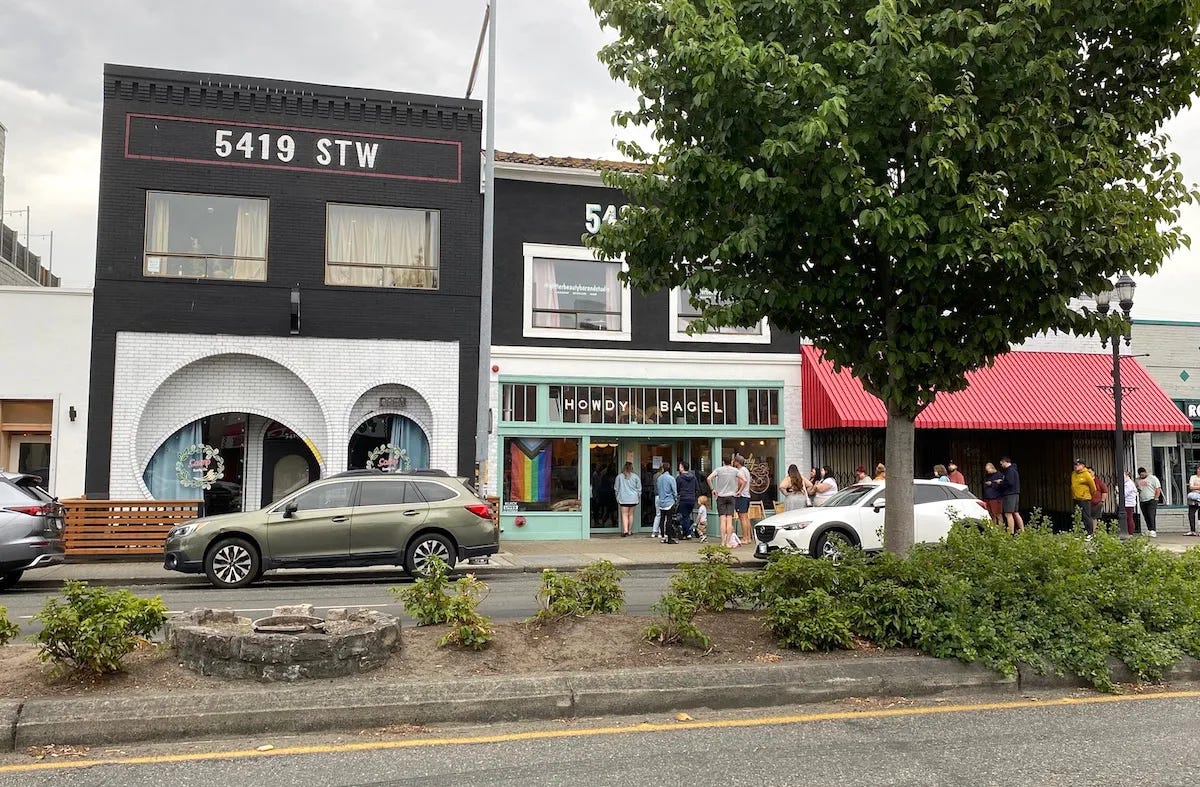How long do you have to wait for a bagel?
So much waiting around for such a simple, humble, and serious food item.
Welcome to It’s A Shanda, one Northeastern Jew’s quest to find a decent bagel in Seattle (and beyond). Along with free bagel reviews every Sunday, we also offer bonus posts each Wednesday. If you’re already subscribed, I hope you’ll consider upgrading to a paid subscription! Thank you for reading.

Bagels are simple.
“A bagel is a round bread made of simple, elegant ingredients: high-gluten flour, salt, water, yeast, and malt,” wrote Ed Levine in 2003 in the New York Times. “Its dough is boiled, then baked, and the result should be a rich caramel color; it should not be pale and blond. A bagel should weigh four ounces or less and should make a slight cracking sound when you bite into it instead of a whoosh. A bagel should be eaten warm and, ideally, should be no more than four or five hours old when consumed. All else is not a bagel.”
Bagels are humble.
“Bagels, it turns out, are very much a bread thread that pulls through hard times, dreams, visions, organizational development, good luck, and good food,” wrote Ari Weinzweig in 2009 in The Atlantic.
Unlike their doughnut counterparts, bagels are serious.
"Although these baked goods are similar in shape, they are wholly different in character,” wrote William Safire in the New York Times in 1999. “Doughnuts are sweet and crumbly, with over 10 grams of fat; bagels are chewy and low in fat. Doughnuts are fun, with sugary smiles, sales peaking at Halloween; bagels are serious, ethnic, and harder to digest."
How then does such a simple, humble, and serious food item inspire the kind of fervor and demand that we see today? How is it that a tiny roll of bread with a hole in it would inspire this newsletter to exist? To say nothing of the lines that wrap around city blocks just so people can order one?
People waiting in long lines for foodstuff isn’t particularly unique in the age of Instagram. It’s not uncommon to see people lining up for a trendy cupcake, outrageous doughnut, or new-in-town Korean fried chicken spot. It often doesn’t even matter if the food is good, so long as it looks cool and helps you get social media cred for having tried it.
Somehow, bagels have found their way into being must-have munchies and there are lines all over the country to prove it. Considering just how many bagels are available to any of us at a given moment, you have to ask…why?
In New York City, PopUp Bagel has become a TikTok sensation and hour-long lines are the norm. Every time trendy Boichick Bagels opens a new shop in the Bay Area, the lines follow with them. Eater Los Angeles described the lines at mega-trendy Courage Bagel as “impossible.” And here in Western Washington, we’ve had our own experiences with the epic Seattle return of Mt. Bagel (which already had soul-crushing lines at pop-ups before leaving) and the hype-driven lines of Howdy Bagel in Tacoma.
I recently visited Howdy Bagel at their brand-new storefront and the 45-minute wait before getting my bagels felt like a breeze compared to the two-hour wait I’d endured the first time. The only thing that was surprising, really, was the resignation that so many of my fellow customers appeared to have about the experience. It was understood that the length of an episode of Succession was a worthy amount of time for the bagel sandwich that awaited you on the other end.
It’s not as though I’ve never waited in line for a bagel before. You wait in line at any decent bagel shop, especially if you arrive on a Sunday morning or mid-week lunchtime. The stark difference is that those situations are often met with speed and efficiency by the staff, whose goal is to get you on your way as soon as possible so they can serve the person behind you.
These lines are a different kind of animal. They often seem purposeful. Or they're driven by a demand that has less to do with eating and more to do with offering proof of purchase to your social media followers. They culminate in elaborate displays and routines that, in turn, create even more demand to do the same.
Perhaps this is my “old man yells at cloud” moment. Having recently turned 45, I suppose I’m due. I’m glad that bagels seem to be having a moment, but I can’t help but wonder if it’s ultimately a good thing.
I spend an inordinate amount of time taking all of this too seriously, and yet my idea of the perfect bagel trip involves a brusque ordering experience, a generic brown bag, and a simple setting of bagels and schmears. No fuss, no muss (except for all the cream cheese that spilled out of the bagel you were eating).
The truth is that whenever I encounter a bagel place that seems to thrive on long lines, I’m suspect. On paper, it shouldn’t, because it might just mean the bagel is really good. But usually, the places where the focus is entirely on the bagel figure out how to cut those lines down in order to let their food do the talking.

When the line itself becomes the selling point, I have to wonder why. I have to assume it’s because there are factors important to the business beyond making the best bagel possible. Maybe that’s wrong and presumptive of me, but I’ve got generations of amazing bagel places back East and elsewhere that seem to prove it’s unnecessary.
Take Bagel Oasis for instance. I’ve talked a lot about how weird it was that the longtime Ravenna bagel shop didn’t show up on most Seattle Best Bagels lists when I started this. Meanwhile, I’ve gotten more emails agreeing with their No. 1 ranking than about any other topic or review I’ve done.
The thing about Bagel Oasis is that they're unassuming. They’re not in the “cool” neighborhoods. They’re not big on Instagram. They’re not trendy. And they don’t have long lines. They just make good bagels.
It says something about the way attention flows in the bagel world, when hype, or the illusion of it, gets translated into which one is the “good” bagel. The new kid on the block does what he feels he needs to do in order to get noticed.
But eventually, the hype recedes and the lines die down. Then, all you’re left with is your product and how well you make it. That’s usually when we know for sure if a place makes a truly good bagel, and whether or not it’s really worth waiting for.
Thanks for actually reading this far. Know someone in the Greater Seattle Area (or beyond) who would appreciate way-too-detailed reviews of local bagels? Please forward the link their way.


